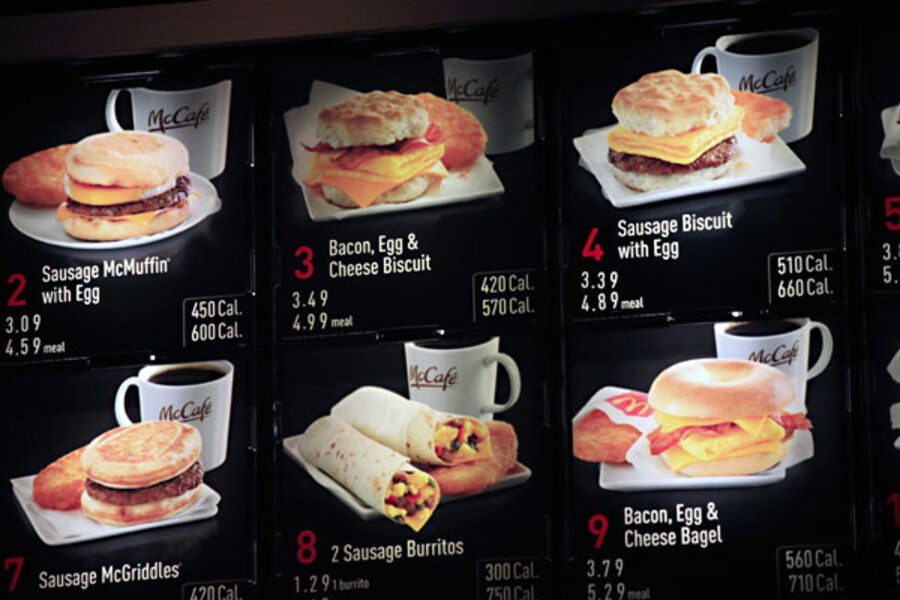McDonald’s adds calorie counts. Will other chains follow? Yes
Loading...
In a move that could have immediate repercussions across the fast food industry, McDonald’s announced Wednesday that it will post calorie counts for all items on its menus in all restaurants and drive-thrus nationwide, starting next week.
“We recognize customers want to know more about the nutrition content of the food and beverages they order,” Jan Fields, president of McDonald’s USA, said in a press statement. “We are pleased to add to the ways we make nutrition information available to our customers and employees.”
“We wanted to voluntarily do this,” Ms. Fields told The Associated Press. “We believe it will help educate customers
McDonald’s already posts calorie counts on menus at locations in a few major cities, including New York and Philadelphia, and the entire state of California, as well as in Australia, South Korea, and the United Kingdom. New York passed a law requiring chain restaurants to do so back in 2008.
The national calorie rollout comes on the heels of the US Supreme Court ruling this past June to uphold President Obama’s health-care law, which included a provision requiring national restaurants with 20 or more locations to post calorie counts. No word yet on when the requirement will go into effect, but when it does, other chains will have to follow McDonald's lead.
"I suspect other companies will follow McDonald’s move, but it won’t benefit them as much," says Tim Calkins, a professor of marketing at the Kellogg School of Management at Northwestern University in Evanston, Ill. "For McDonald's, it builds the brand's perception of being a leader in terms of transparency."
It isn’t clear that disclosing calorie information impacts eating habits, so McDonald’s isn’t taking a major risk.
Not that it would be the first chain with calorie counts. Subway, which markets itself as a healthier alternative to the burger joints that dominate the fast food industry, already does it, and Panera Bread Company started posting calorie counts nationally back in 2010. But McDonald's is the biggest game in town, with 14,000 locations across the US and the perennial winner in terms of gross profits. McDonald’s calorie display rollout may mean that its closest competitors – Burger King, Wendy’s, and the like – will be forced from a public relations standpoint to do the same, well before regulations force the change. Industry experts expect that to be sometime in early 2013, after election season has passed.
McDonald’s also announced that the Oak Brook, Illinois-based company is testing more health conscious menu options, including more seasonal fruit and vegetables, grilled chicken for happy meals, and a breakfast sandwich made with egg whites on a whole grain English muffin (working title: the Egg White Delight). In March 2012, it began automatically including apple slices in Happy Meals, alongside a reduced portion of fries.
"It isn’t clear that disclosing calorie information impacts eating habits, so McDonald’s isn’t taking a major risk," Calkins says.
McDonald’s executives have publicly opposed calls for calorie postings in the past, noting that they have always had nutrition information available on their website, on the back of placemat menus, or upon request to anyone who cared to ask. Fields, too, took care to point out to AP that calorie counts in New York and other markets didn’t translate to any significant change in customers’ eating habits.
Still, the National Restaurant Association welcomed the new ruling, initially proposed by the Food and Drug Administration, because it would unify the regulations and make them easier to follow. Before, restaurants had to face varying regulations across an increasing number of cities introducing calorie requirements for restaurants.








